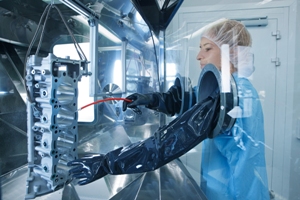Oct 19 2013
Fraunhofer Institute for Manufacturing Engineering and Automation IPA will present a new laboratory for industrial cleaning at the parts2clean trade fair in Stuttgart, October 22-24, 2013. Thanks to “CleanLab 2020,” dirt particles on a scale ranging from the nano to the micro and found on and in components, surfaces and liquids in a wide variety of industries can be analyzed for the first time.
At the same time a contiguous clean room provides a site where components can be cleaned and any impurities extracted and investigated.
 From engine block to cloth wipe: “CleanLab 2020” comprises the entire bandwidth of industrial cleanliness technology in a single cleanroom concept. © Fraunhofer IPA
From engine block to cloth wipe: “CleanLab 2020” comprises the entire bandwidth of industrial cleanliness technology in a single cleanroom concept. © Fraunhofer IPA
When it comes to cleanliness, we tend to think of “dust bunnies” cheerfully frolicking through the home, or perhaps of a vacuum cleaner designed to put an end to their merriment. But cleanliness is a topic of concern for automobile technicians, dental technicians and aerospace engineers, too. Because brake lines, dental implants and samples from space only function as they should or submit to clear identification if they are clean.
The cleaning processes used are as varied as the industries themselves. In the semiconductor industry, even particles on the nanometer scale are unwelcome. In the medical field, the threshold is in the vicinity of 5 micrometers, while in automobile production the trouble starts at 200 micrometers. The techniques used to evaluate purity vary as well: optical procedures are well-suited for hunting down dirt on smooth surfaces such as silicon wafers. In the case of hollow components such as oil lines, brake lines or screw threads, the particles must first be rinsed out and filtered before they can be analyzed. Impurities can be the result of oils, metal abrasion in machinery and components, or even organic sources such as human beings.
At IPA, for more than 25 years researchers in the “Ultraclean Technology and Micromanufacturing” department have specialized in production in cleanroom conditions. Markus Rochowicz describes two of their current challenges: “First, there are now some 1000 industrial laboratories that investigate components for impurities. Yet to my knowledge, there is still no cross-sectoral concept that can be applied within a contiguous cleanroom. And second, to accommodate their often very complex component geometries, the automobile industry has devised methods that can benefit other industries as well. With the new laboratory, the IPA seeks to introduce this knowledge to other branches of industry that are sensitive to purity issues.” So right in time for parts2clean, then, researchers have opened their “CleanLab 2020.” An innovation designed to close these very gaps in the analysis of impurities: by creating a contiguous cleanroom for purification, extraction and analysis, the new laboratory provides an uninterrupted material flow. It offers the entire spectrum of current, conventional technologies for the analysis of impurities. In particular, rinsing concepts derived from the automobile industry can be used in other sectors as well.
The analytical laboratory is around 100 square meters in size and offers room for about four or five scientists. A system of airlocks provides a cleanroom link between the analytical laboratory and the cleanliness laboratories already in place at IPA. The researchers in Stuttgart have developed particularly extensive capacity in purification through carbon dioxide in recent years. IPA is also home to the world’s cleanest cleanroom. “CleanLab 2020” is divided into two main laboratory areas: in the first, any impurities are extracted from components brought in, and in the second the impurities are filtered and analyzed. Rochowicz and his colleagues can remove the particles using different rinsing chambers, ultrasound baths, or closed ducting such as purging systems. There are six different optical and scanning electron microscope systems available to provide geometric measurements and complete analyses of impurities. The scientists can use a micro-scale computer tomography to display and measure the particles in three dimensions. This gives them an insight into the interior of components. A directed flow of air ensures that the environment at all workstations is kept “ultraclean.” “This way, we can analyze the cleanliness of nearly any object in search of particles in the sub-nano to upper micrometer range. Since the laboratory complex is now integrated in our training concept, industrial users can benefit from the new capabilities available,” Rochowicz says, describing the laboratory’s bandwidth.
There are three opportunities for visitors to view a live feed of work in the new laboratory at the joint Fraunhofer-Gesellschaft exhibition stand (Hall 6, Booth 6214/6313) and visit with researchers on site:
Tuesday, October 22, 2013, 11:00 a.m.
Wednesday, October 23, 2013, 11:00 a.m.
Wednesday, October 23, 2013, 3:00 p.m.